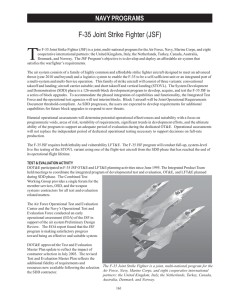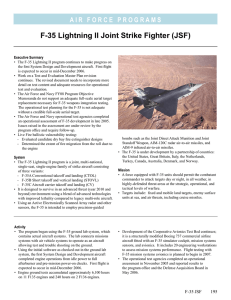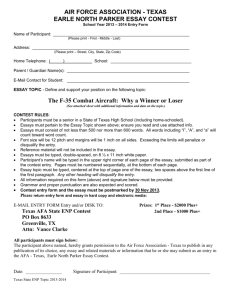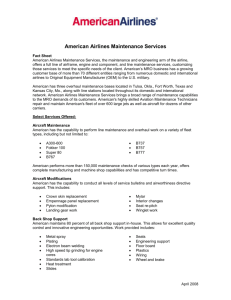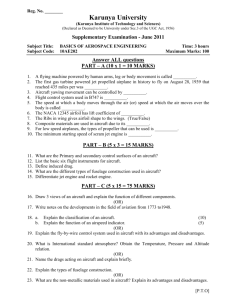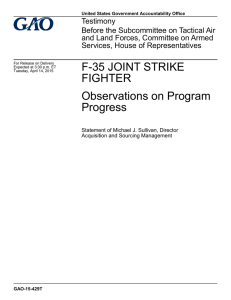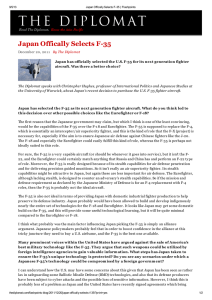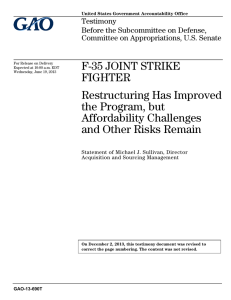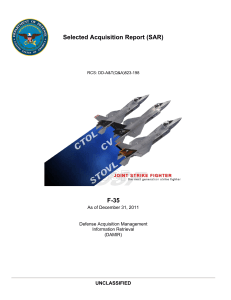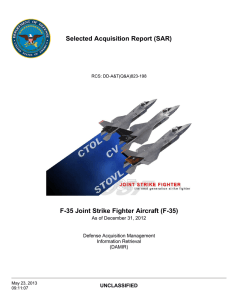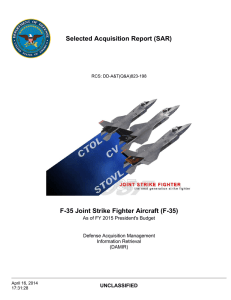F-35 Joint Strike Fighter (JSF)
advertisement
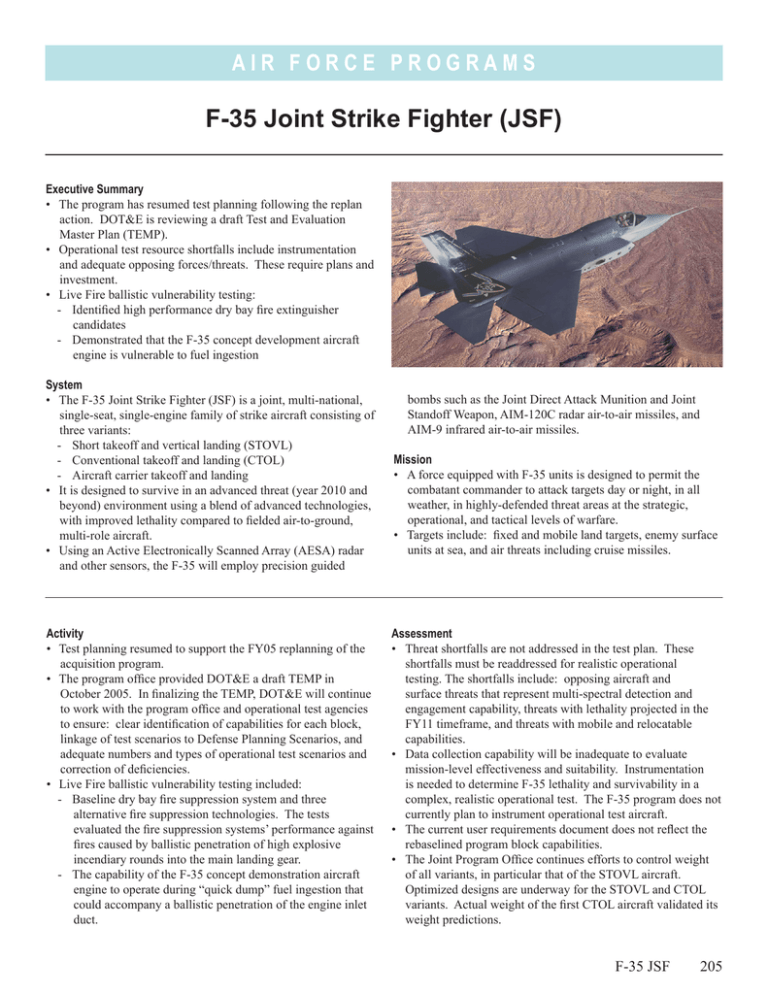
AIR FORCE PROGRAMS F-35 Joint Strike Fighter (JSF) Executive Summary • The program has resumed test planning following the replan action. DOT&E is reviewing a draft Test and Evaluation Master Plan (TEMP). • Operational test resource shortfalls include instrumentation and adequate opposing forces/threats. These require plans and investment. • Live Fire ballistic vulnerability testing: - Identified high performance dry bay fire extinguisher candidates - Demonstrated that the F-35 concept development aircraft engine is vulnerable to fuel ingestion System • The F-35 Joint Strike Fighter (JSF) is a joint, multi-national, single-seat, single-engine family of strike aircraft consisting of three variants: - Short takeoff and vertical landing (STOVL) - Conventional takeoff and landing (CTOL) - Aircraft carrier takeoff and landing • It is designed to survive in an advanced threat (year 2010 and beyond) environment using a blend of advanced technologies, with improved lethality compared to fielded air-to-ground, multi-role aircraft. • Using an Active Electronically Scanned Array (AESA) radar and other sensors, the F-35 will employ precision guided Activity • Test planning resumed to support the FY05 replanning of the acquisition program. • The program office provided DOT&E a draft TEMP in October 2005. In finalizing the TEMP, DOT&E will continue to work with the program office and operational test agencies to ensure: clear identification of capabilities for each block, linkage of test scenarios to Defense Planning Scenarios, and adequate numbers and types of operational test scenarios and correction of deficiencies. • Live Fire ballistic vulnerability testing included: - Baseline dry bay fire suppression system and three alternative fire suppression technologies. The tests evaluated the fire suppression systems’ performance against fires caused by ballistic penetration of high explosive incendiary rounds into the main landing gear. - The capability of the F-35 concept demonstration aircraft engine to operate during “quick dump” fuel ingestion that could accompany a ballistic penetration of the engine inlet duct. bombs such as the Joint Direct Attack Munition and Joint Standoff Weapon, AIM-120C radar air-to-air missiles, and AIM-9 infrared air-to-air missiles. Mission • A force equipped with F-35 units is designed to permit the combatant commander to attack targets day or night, in all weather, in highly-defended threat areas at the strategic, operational, and tactical levels of warfare. • Targets include: fixed and mobile land targets, enemy surface units at sea, and air threats including cruise missiles. Assessment • Threat shortfalls are not addressed in the test plan. These shortfalls must be readdressed for realistic operational testing. The shortfalls include: opposing aircraft and surface threats that represent multi-spectral detection and engagement capability, threats with lethality projected in the FY11 timeframe, and threats with mobile and relocatable capabilities. • Data collection capability will be inadequate to evaluate mission-level effectiveness and suitability. Instrumentation is needed to determine F-35 lethality and survivability in a complex, realistic operational test. The F-35 program does not currently plan to instrument operational test aircraft. • The current user requirements document does not reflect the rebaselined program block capabilities. • The Joint Program Office continues efforts to control weight of all variants, in particular that of the STOVL aircraft. Optimized designs are underway for the STOVL and CTOL variants. Actual weight of the first CTOL aircraft validated its weight predictions. F-35 JSF 205 AIR FORCE PROGRAMS • Live Fire testing: - Identified a candidate fire suppressor that successfully demonstrated dry bay fire suppression in the main landing gear bay using less agent and longer time delays than the original design. This more robust design allows for the placement of redundant fire suppressors that could extinguish fires even if a single suppressor is destroyed by fragments from a ballistic threat. - Results from the “quick dump” fuel ingestion test showed significant damage to the concept demonstration aircraft engine. A new concept demonstration aircraft engine may be required to continue Live Fire testing. The program is disassembling the damaged engine to determine what components failed, and to evaluate whether the production configured engine could fail in a similar way due to fuel ingestion. Recommendations 1. Develop an F-35 data collection and range interface capability that enables precise mission replay and data capture to evaluate mission-level effectiveness and suitability. 206 F-35 JSF 2. Identify all test resource shortfalls in opposing force/threats and present a solution that mitigates these. 3. Align the requirements for each block with the replanned program. 4. Develop a predictive model to determine how test data on engine performance following “quick dump” fuel ingestion at the sea level test site could be extrapolated to predictions for higher operating altitudes. 5. Reduce the fuel ingestion vulnerability. This could be done, for example, by improving the fuel bladders around the inlet ducts or improving the engine design to be more tolerant to “quick dump” fuel ingestion.
